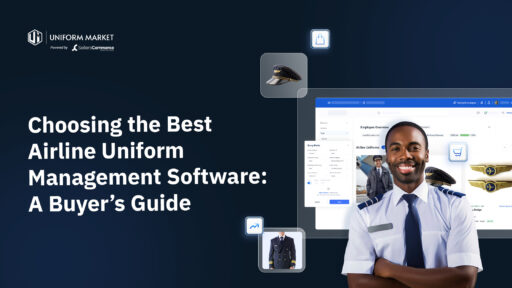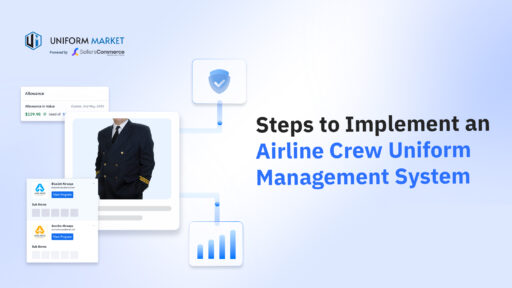Airlines are raising the bar on what they expect from their uniform programs. They want stock availability across every base so shortages never delay a crew. They want predictable delivery timelines so new hires and seasonal refreshes happen without disruption. They expect strict compliance with role-based and union-specific policies. And they want data. Clear, real-time insight into usage, spend, and garment performance, to guide their operational decisions.
Over 80% of airlines are increasing investment in technology to improve operational efficiency.
For airline uniform providers, this means that their success also depends on the ability to coordinate inventory across hubs, anticipate demand, and give airlines visibility into every stage of the process. This is where an airline crew uniform management system can help. In this guide, we will explore nine ways it helps uniform providers work smarter and keep airlines running efficiently:
- Multi-Hub Inventory Visibility and Transfers
- Automated Entitlements and Access Controls
- Self-Service Portals
- Budget Control and Allowance Enforcement
- Flexible Multi-Location Uniform Delivery
- Sizing Accuracy and First-Time Fit
- Lifecycle Tracking, RFID, and Returns
- Forecasting and Reporting
- Brand, Safety, and Passenger Experience
1. Multi-Hub Inventory Visibility and Transfers
Multi-hub inventory visibility means tracking and managing uniform stock across different airlines and bases so the right items are always in the right place. Airlines operate across multiple hubs, so without real-time visibility into what is available at each location, issues like stockouts and overstock are almost inevitable. This often leads to:
- Rushed orders with extra costs for expedited shipping, overtime production, and special handling
- Delays in outfitting the crew that affect readiness for new hires or seasonal gear changes
- Inefficient transfers where stock is moved without accurate demand data, causing unnecessary shipments
How a Uniform Management System Supports Uniform Providers
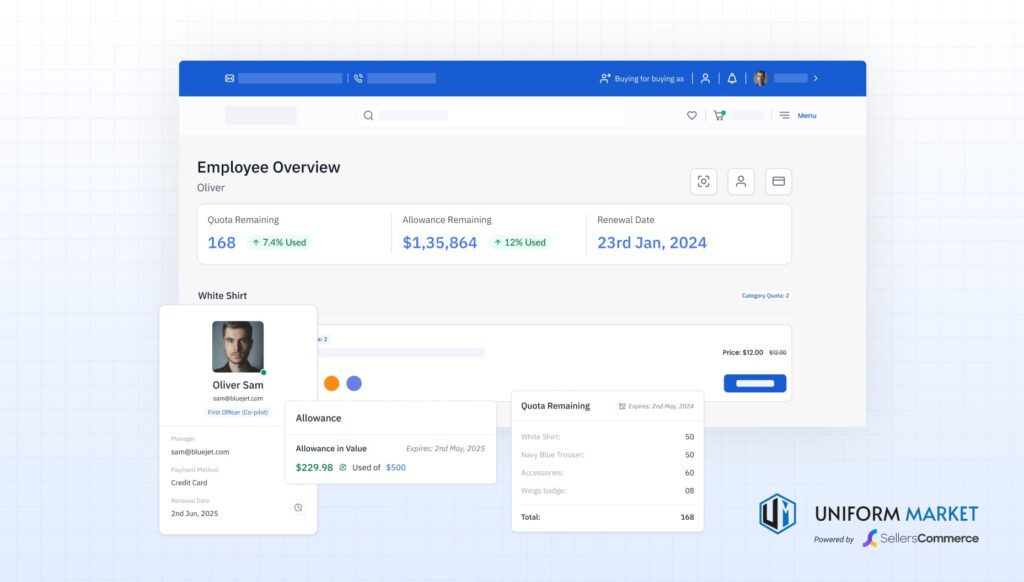
A uniform management system gives suppliers and airline administrators a complete picture of stock across all hubs. Through a unified admin portal like one provided by UniformMarket, suppliers can manage multiple airline clients in one place, even when each program has different stock profiles and distribution points. Features include:
- Tracking by location and detail to monitor items by base, size, style, and season
- Automated low-stock alerts to act before shortages occur
- Smart transfer recommendations to move surplus where it is needed most, avoiding unnecessary purchases
These capabilities reduce waste, keep uniforms available where and when they are needed, and strengthen the supplier’s role as a proactive operations partner.
2. Automated Entitlements and Access Controls
Automated Entitlements and Access Controls are features in the uniform management system that automatically let you apply rules that control what each crew member can order, how much they can order, and when, so they only see the items they are allowed to access.
Airline uniform programs have complex entitlements, i.e., the specific uniform items and quantities for each crew member vary by role, seniority, base, season, and union agreement. Without automation, mistakes are common, such as:
- Incorrect kit allocations where the crew receive items they are not eligible for or miss required pieces
- Policy compliance issues from overlooked allowances or seasonal requirements
- Time-consuming manual checks by coordinators for each order
How a Uniform Management System Supports Uniform Providers
A uniform management system applies entitlement rules automatically at the point of order. Uniform Providers can configure the system so each client’s crew sees only approved items for their role and location, with policies enforced every time. This includes:
- Role-based catalogs so each crew type only views items they are eligible for
- Location and seniority filters for regional variations or rank-specific gear
- Built-in policy compliance for allowances, seasonal gear, or special accommodations
Automation reduces admin work, prevents costly order errors, and helps suppliers deliver consistent, policy-compliant uniforms across multiple airline clients.
Example: A supplier managing uniforms for a pilot training academy can set the system so students, instructors, and admin staff each see only their approved kit, with seasonal items appearing automatically for cold-weather locations.
3. Self-Service Portals
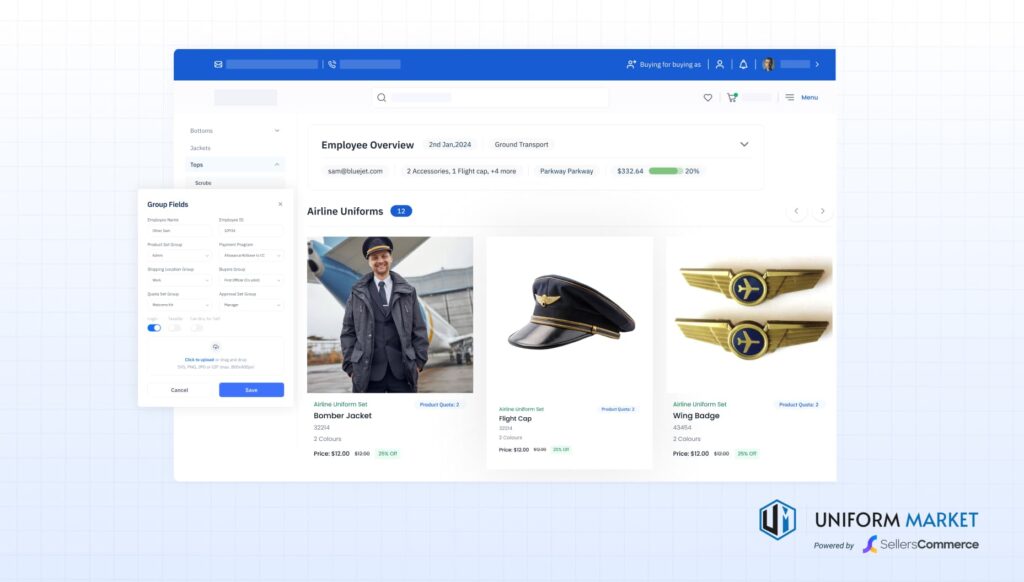
Self-service portals are online platforms where crew can order, exchange, and track uniforms without relying on coordinators or unnecessary manual processes. Without self-service portals, every uniform request would have to pass through emails, phone calls, or paper forms, which often leads to:
- Delays in order processing as coordinators handle requests one at a time
- Higher support workloads from repetitive queries about allowances, sizes, or order status
- Greater risk of errors from manual data entry or miscommunication
How a Uniform Management System Supports Uniform Providers
A uniform management system with self-service portals allows suppliers to give airline crew direct access to manage their uniform needs, while still controlling what each person can see or order. Through a unified portal, uniform providers can set up and manage portals for multiple airline clients, each with their own branding and policies. Key capabilities of self‑service portals include:
- Role-filtered catalogs so the crew only sees approved items for their position
- Real-time allowance balances are visible before placing an order
- Order tracking and exchange requests that can be submitted anytime, from anywhere
These features reduce back-and-forth with coordinators, cut down on manual admin work, and improve accuracy in orders.
Example: A supplier working with a helicopter tour company can set up a portal where pilots, ground staff, and maintenance teams log in separately, see only their approved uniforms, and place orders directly without going through management each time.
4. Budget Control and Allowance Enforcement
Budget control and allowance enforcement mean tracking how much each crew member is allowed to spend or order, and making sure those limits are followed automatically. Without this, airlines risk overspending, confusion, and manual reconciliation. Common issues include:
- Overused allowances when the crew can’t see their real-time balances, which can lead to unintentional overspending and extra reconciliation work
- Manual approvals for over-limit orders can slow down fulfillment and increase the coordinator’s workload
- Lack of audit trails makes it harder to track transactions, enforce policies, or prepare accurate reports
How a Uniform Management System Supports Uniform Providers
A uniform management system helps suppliers enforce client-specific budgets and allowances through rules set at the individual, team, or department level. Within a unified portal, uniform providers can manage different allowance models for multiple airline clients in one place.
Key features include:
- Real-time tracking of balances and limits so the crew sees what they have left before placing an order
- Automated alerts and approvals that notify the crew when they exceed their allowance and route the order to a supervisor or coordinator for review before it’s processed
- Built-in audit trails like UniformMarket’s ledger that log every transaction and policy decision, making it easier to generate financial reports and review compliance during audits
This reduces disputes, speeds up ordering, and gives suppliers better control over program compliance without manual tracking.
5. Flexible Multi-Location Uniform Delivery
Flexible multi-location delivery means getting uniforms to wherever the crew will be, not just their home base. Airline crews often change bases, attend training in different cities, or work seasonal routes. Without flexible multi-location delivery, uniforms may be shipped to the wrong place or arrive too late. This can result in:
- Missed deliveries can delay crew readiness and leave the crew without compliant uniforms for scheduled flights or training sessions, which can disrupt staffing and force costly last-minute adjustments
- Increased shipping costs from resending or rerouting orders when crew assignments change unexpectedly
- Stock bottlenecks occur when uniforms pile up in one place while other locations run short
How a Uniform Management System Supports Uniform Providers
A uniform management system allows suppliers and distributors to route orders to where the crew will actually be. Through a unified portal, they can manage fulfillment for multiple airline clients at once, even when each program has different delivery needs. This includes:
- Multiple delivery addresses per crew member, so orders can be sent to a home base, training center, or layover hub
- Smart routing logic that matches delivery location with upcoming assignments or seasonal changes
- Centralized fulfillment management so suppliers can monitor and adjust deliveries for all clients in one place
These capabilities reduce last-minute reshipments, lower logistics costs, and get uniforms to the crew faster and in the right location.
Example: A supplier serving a private flight agency can use a uniform management system to send uniforms for a new cabin crew team directly to their training facility, ensuring they are equipped and ready before their first assignment.
6. Sizing Accuracy and First‑time Fit
Sizing accuracy and first-time fit refer to how well the uniform management system helps the crew get the right size the first time they order. This feature reduces exchanges, returns, and delays. Without sizing support tools in place, suppliers and airlines often face:
- High return rates due to incorrect sizing, especially during onboarding or large rollouts
- Crew dissatisfaction and discomfort from poorly fitted garments that affect performance
- Extra handling and shipping costs from frequent exchanges or reorders
How a Uniform Management System Supports Uniform Providers
A uniform management system helps suppliers and distributors deliver better fit results through guided tools and historical data. Features include:
- Stored sizing history that tracks what fit best in the past for easy reordering
- Standardized size charts and optional measurements to improve accuracy at the point of order
- Fit validation rules that flag missing or unusual size entries before checkout
These features reduce sizing-related returns, build crew confidence, and help suppliers scale uniform delivery across programs with less manual correction.
Example: A supplier working with a pilot school can use stored sizing data and standardized charts to pre-load fit recommendations for returning students, reducing errors during high-volume uniform rollouts.
7. Lifecycle tracking, RFID, and Returns
Lifecycle tracking refers to monitoring each uniform item from the moment it is issued to when it is returned, replaced, repaired, or retired. When tracking is handled manually or inconsistently, suppliers and airlines often face:
- Lost or unaccounted garments due to no clear record of who received which item
- Unplanned reorders or early replacements because the system doesn’t track how long items have been in use
- Inaccurate audits occur when uniforms are not tagged or scanned reliably across locations
How a Uniform Management System Supports Uniform Providers
A uniform management system helps suppliers track the full journey of every garment by recording activity and linking items to crew profiles. It can also support RFID and barcode workflows, making inventory control more accurate and efficient. Key features include:
- Garment-to-user assignment so each uniform issued is linked to a specific crew member, improving accountability
- Lifecycle event logging to track issue dates, exchanges, repairs, and disposals for each item
- Support for RFID or barcode scanning by integrating with external scanners and capturing scan data in the system. This allows suppliers to automate inventory checks, track movement across locations, and maintain accurate records without manual entry
These capabilities reduce uniform loss, improve audit readiness, and give suppliers better visibility into usage trends and replacement cycles across all programs.
8. Forecasting and Reporting
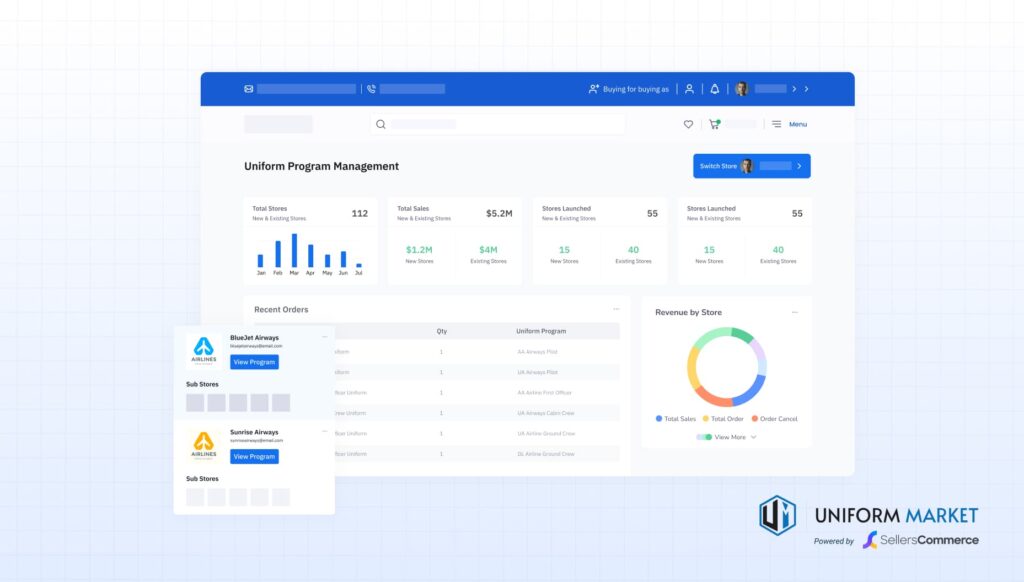
Forecasting and reporting refer to the ability to use real-time data from the uniform program to make informed decisions about inventory, budgeting, and supplier performance. Without these tools, suppliers and airlines face:
- Over-ordering or understocking due to a lack of insight into actual usage patterns
- Limited visibility into return rates or fit issues that could be resolved through better planning
- Manual reporting processes that slow down audits and delay operational reviews
How a Uniform Management System Supports Uniform Providers
A uniform management system gives uniform providers access to live data and built-in reporting tools. Through a unified portal, they can monitor program activity across multiple airline clients and make proactive decisions. Key features include:
- Usage trend reports that show which items are frequently ordered, returned, or replaced
- Return and exchange tracking to flag high-return products or sizing issues that may need to be addressed
- Forecasting tools to help suppliers plan production, restocking, or rollout schedules based on actual demand patterns
These insights allow suppliers to anticipate needs, avoid waste, and demonstrate program value with clear, data-backed reporting.
Example: A supplier serving a charter operator can use return data from the system to identify a high volume of shirt exchanges. This could prompt a sizing chart update, reducing future errors and improving crew satisfaction.
9. Brand, Safety, and Passenger Experience
Uniform programs are also a visible extension of an airline’s brand, a factor in crew comfort and safety, and a subtle influence on how passengers perceive professionalism and service quality. When uniform programs are inconsistent or poorly managed, airlines and suppliers may face:
- Brand misalignment occurs when crew uniforms vary across locations or are not updated consistently
- Safety risks and discomfort from ill-fitting, low-quality, or non-compliant garments, especially for specialized roles
- Negative passenger impressions when uniforms appear worn out, mismatched, or out of sync with the airline’s image
How a Uniform Management System Supports Uniform Providers
A uniform management system helps suppliers and distributors uphold brand consistency, enforce safety requirements, and support a high-quality crew experience. Key features include:
- Integrated embroidery customization that allows logos, name personalization, and brand insignia to be applied during the ordering process, ensuring garments align with brand standards and are passenger-ready upon delivery
- Built-in support for accommodations and compliance, such as allergy-safe fabrics, maternity options, and role-based safety gear
- Centralized catalog and distribution tools to ensure uniform rollouts, replacements, and refreshes stay consistent across all crews and locations
These capabilities help suppliers protect the airline’s brand identity while improving crew satisfaction and passenger-facing presentation.
Conclusion
Airlines today expect more from their uniform suppliers. They want real-time visibility, consistent policy enforcement, faster fulfillment, and a uniform program that supports both crew performance and brand standards.
To meet these expectations, uniform providers need systems that are built for scale and complexity. UniformMarket provides the tools to manage multiple airline clients through a single platform, automate critical processes, and deliver consistent results with less manual work.
From entitlement rules to stock visibility, sizing accuracy, and lifecycle tracking, a uniform management system helps suppliers run smarter programs and become stronger partners to the airlines they serve.

